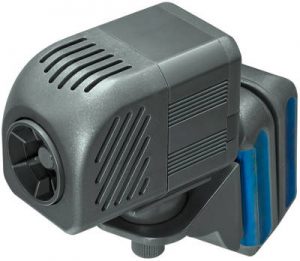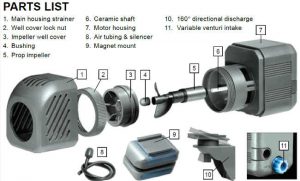
View On Amazon
| Size | Dimensions | Tank Size | Noise Level | Longevity | Price |
| 320 GPH | 2.5″ x 1.5″ x 1.9″ | 8-30 Gallons | Low | 2-6 Years | Medium |
Seio’s P320 prop pump is a decent pump but suffers a bit when produced in this small size. The ceramic shaft, one of the drawing features, is a bit too brittle when this small and can break after frequent use. Otherwise the powerhead performs well and is fairly quiet.
Because the shaft is more likely to break I highly recommend you hop over to my Tunze 6015 powerhead review. It costs a bit more but you’ll get a whole lot more bang for your buck.
Set-up

The little Seio P320 is quick and easy to set up. Simply pull off the front grate, slide the magnetic base into place on the bottom of the powerhead and reattach the front grate. Ready to install.
These magnets are strong, but not too strong. They can hold on glass up to 1/4″ thick. Keep a firm grip on both magnets when placing the powerhead. Ideally you will hold the powerhead against the glass on the inside of the tank while brining the exterior magnet into place. For the safest method you should bring the exterior magnet to the glass above its final resting place. After it is touching the glass you will want to slide the magnet down. This removes the risk of the magnets jumping together, crashing into the glass between them.
The cord is 6 feet long, which is really generous for the tanks it’s meant for. Honestly you will likely leave some of it coiled up behind the tank.
The box like shape is a bit difficult to hide, even with how small the powerhead is. The box shape does, however, allow it to more evenly distribute the water. This often leads people to believe Seio brand powerheads don’t move as much water as listed. They do, but it just feels weak as it is over a bigger area.
Once the powerhead is switched on you will hear a fair bit of clattering before the pump switches to a near silent hum. This is the impeller finding its place in the motor. Due to the small size the ceramic shaft can break more easily than most models. Try to start up the powerhead as few times as possible, as the clattering stage is the main time when this will break.
Assembly

The body features many small grates which are too small for any fish to enter but not so small that they inhibit the waters flow rate.
For assembling and disassembling, this powerhead takes a bit more work than most. You will need to start by removing the powerhead from water. Remember there is an external magnet attached to the powerhead. Put this somewhere where it won’t cause any trouble.
With the powerhead out of the tank, preferably over a sink to catch all the hidden water(towels are never enough), you will need to remove the main housing and well cover lock nut. Removing these exposes the impeller well cover.
After removing the well cover you can clean out the impeller, ceramic shaft and mount inside the powerhead. These are the key areas to clean, as they are the main source of powerhead failures across most brands. With Seio’s ceramic shaft they are well up there on this danger.
To clean the impeller and shaft you will need to soak them in a solution of 50% water and 50% vinegar for no less than 15 minutes. After this time you can wipe them clean using a soft material. I prefer to use cotton swabs, as they never have any chemicals on them and are easy to keep on hand.
Rinse off the components and reassemble the powerhead in reverse order. Return it to the tank and remember to be careful with those magnets!
Flow & Adjustments
The flow rate of the Seio P320 cannot be adjusted. Furthermore it is almost sure to break if you try and use it with a pulse or wave maker controller. Just do not even try it. Even successful set-ups will create a lot of noise each time the powerhead switches on.
The direction can be set within a 160 degree arc by turning the head. The powerhead can be adjusted further by turning the two magnets that are holding it in place. Remember: The flow on this unit is much more distributed than the average powerhead. Aiming it slightly downwards can cause a sandstorm. Start out with the powerhead facing straight forward and fine tune it.
Warranty & Lifetime
Seio provides a decent 6 month warranty on the P320 prop pump. This will catch most faulty units, as the main culprit is broken on arrival ceramic shafts. Remember to inspect the powerhead during its final month of warranty and ask Seio any questions you could have. Once the warranty ends you will need to complete a form to custom order extra parts.
The lifetime on this powerhead varies with two things: luck and care. I cannot stress enough how risky the ceramic shaft is when created this small. The other units hold up just fine but this model worries me too much to recommend. When the shaft does not break and the powerhead is well cared for it can easily live between 2-6 years. Overall it’s a pretty good pump, but I personally would spend a bit more for a Tunze. Now those are powerheads you can count on for over a decade of service.